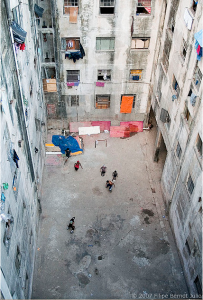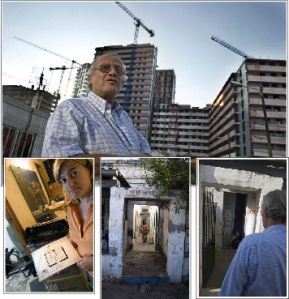 -How sad it is... they finally managed to get what they wanted: a dead neighborhood, with no life in it. What will I do? I will die inside that flat. I don't know what to do in that balcony, I just read the newspaper... so I come back here, to see if I find somebody to chat a while, like I always did. We like to be in the streets...
-How sad it is... they finally managed to get what they wanted: a dead neighborhood, with no life in it. What will I do? I will die inside that flat. I don't know what to do in that balcony, I just read the newspaper... so I come back here, to see if I find somebody to chat a while, like I always did. We like to be in the streets... (a neighbor of "Colonia Castells")
Barcelona is changing. From a "lowercase" city, made of small one-storey houses, to an "Uppercase" city: Big Intensive Buildings, Vertical Standardization, Big Commercial Avenues. In "Colonia Castells", a small "residual" one-storey neighborhood, just below Barcelona's most important commercial areas (the Diagonal avenue), decades of plans and projects managed to convert an ancient working class neighborhood built in the 20s, into a
transitional space, constantly waiting for the demolition: an urbanistic and social "death row".
The residents of this and others "black holes"
embody the precariousness and uncertainty in which they are banished, and begin to present the symptoms of an individual and collective "urban renewal syndrome", that
breaks the community bounds and strengthens both individualism and general diffidence. The neighborhood turns into a sad and uncomfortable place to stay, and the same inhabitants who once loved it now forcedly end up wishing to leave it.

 -How sad it is... they finally managed to get what they wanted: a dead neighborhood, with no life in it. What will I do? I will die inside that flat. I don't know what to do in that balcony, I just read the newspaper... so I come back here, to see if I find somebody to chat a while, like I always did. We like to be in the streets... (a neighbor of "Colonia Castells")
Barcelona is changing. From a "lowercase" city, made of small one-storey houses, to an "Uppercase" city: Big Intensive Buildings, Vertical Standardization, Big Commercial Avenues. In "Colonia Castells", a small "residual" one-storey neighborhood, just below Barcelona's most important commercial areas (the Diagonal avenue), decades of plans and projects managed to convert an ancient working class neighborhood built in the 20s, into a transitional space, constantly waiting for the demolition: an urbanistic and social "death row".
The residents of this and others "black holes" embody the precariousness and uncertainty in which they are banished, and begin to present the symptoms of an individual and collective "urban renewal syndrome", that breaks the community bounds and strengthens both individualism and general diffidence. The neighborhood turns into a sad and uncomfortable place to stay, and the same inhabitants who once loved it now forcedly end up wishing to leave it.
-How sad it is... they finally managed to get what they wanted: a dead neighborhood, with no life in it. What will I do? I will die inside that flat. I don't know what to do in that balcony, I just read the newspaper... so I come back here, to see if I find somebody to chat a while, like I always did. We like to be in the streets... (a neighbor of "Colonia Castells")
Barcelona is changing. From a "lowercase" city, made of small one-storey houses, to an "Uppercase" city: Big Intensive Buildings, Vertical Standardization, Big Commercial Avenues. In "Colonia Castells", a small "residual" one-storey neighborhood, just below Barcelona's most important commercial areas (the Diagonal avenue), decades of plans and projects managed to convert an ancient working class neighborhood built in the 20s, into a transitional space, constantly waiting for the demolition: an urbanistic and social "death row".
The residents of this and others "black holes" embody the precariousness and uncertainty in which they are banished, and begin to present the symptoms of an individual and collective "urban renewal syndrome", that breaks the community bounds and strengthens both individualism and general diffidence. The neighborhood turns into a sad and uncomfortable place to stay, and the same inhabitants who once loved it now forcedly end up wishing to leave it. 


 “…on saturdays we went out, and she and her sister remained with our neighbor, miss Maria, and wouldn't come with us. [...] We would have taken them to the cinema, to Mcdonald’s, but they didn't want! They wanted to stay here in the alley“.
“…on saturdays we went out, and she and her sister remained with our neighbor, miss Maria, and wouldn't come with us. [...] We would have taken them to the cinema, to Mcdonald’s, but they didn't want! They wanted to stay here in the alley“.